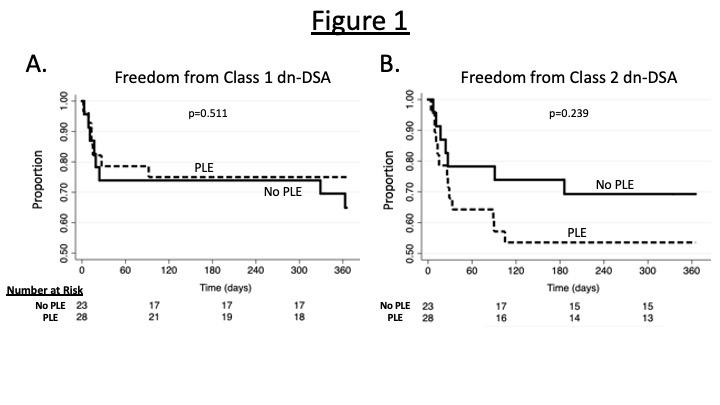De Novo Donor Specific Antibodies After Heart Transplantation in Fontan Patients with Protein Losing Enteropathy
1Pediatric Cardiology, Lurie Children's Hospital, Chicago, IL, 2Northwestern School of Medicine, Chicago, IL, 3Department of Surgery, Northwestern University Feinberg School of Medicine, Chicago, IL, 4Pediatric Cardiothoracic Surgery, Lurie Children's Hospital, Chicago, IL
Meeting: 2021 American Transplant Congress
Abstract number: 649
Keywords: Antibodies, Heart, Pediatric
Topic: Clinical Science » Biomarkers, Immune Assessment and Clinical Outcomes
Session Information
Session Name: Biomarkers, Immune Assessment and Clinical Outcomes
Session Type: Poster Abstract
Session Date & Time: None. Available on demand.
Location: Virtual
*Purpose: Protein Losing Enteropathy (PLE) complicates Fontan physiology and can be an indication for heart transplantation (HT). PLE is accompanied by immune dysregulation, potentially impacting antibody production; the impact of PLE on the development of donor specific antibodies (DSAs) is unclear. De novo DSAs (dnDSAs) incur graft damage, increasing risk for rejection and coronary artery vasculopathy. We investigated the development of dnDSAs in the first year after HT in Fontan patients with and without PLE.
*Methods: A retrospective chart review was conducted of Fontan patients who underwent HT at our institution. Diagnosis of PLE was based on clinical features and/or laboratory data. Patients were excluded if they lacked pre-transplant or post-transplant DSA data. Characteristics between the two groups were compared using Wilcoxon Rank Sum and Fisher’s Exact Test as appropriate. Freedom from dnDSAs and 1 year graft survival were assessed using Kaplan Meier curves and compared using the Log Rank Test.
*Results: Over the 12 years, 51 Fontan patients underwent HT and had sufficient antibody data. Twenty-eight (55%) had PLE and 23 (45%) did not. Baseline demographics were similar between those with and without PLE. Peak panel of reactive antibodies (PRA) prior to HT was similar for both Class 1 (no PLE: 4[0-41%] vs PLE: 6[0-48%], p=0.61) and Class 2 (no PLE: 0[0-19%] vs PLE: 0[0-25%], p=0.55) antibodies. Freedom from class 1 dnDSA post-HT was the same between two groups (Figure 1A). Though not statistically different, there was a trend towards lower freedom from class 2 dnDSA in the PLE group (Figure 1B). Graft survival was similar between the two groups.
*Conclusions: Despite similar pre-HT PRA, Fontan patients with PLE trended towards earlier class 2 dnDSAs, however this study may have been underpowered to detect true differences. Early graft survival did not differ between the groups. A larger scale analysis would offer insight into the risk of dnDSA production and long term graft failure in Fontan patients transplanted for PLE.
To cite this abstract in AMA style:
Magnetta DA, Hoch V, Pinelli D, Monge M, Pahl E, Thrush PT. De Novo Donor Specific Antibodies After Heart Transplantation in Fontan Patients with Protein Losing Enteropathy [abstract]. Am J Transplant. 2021; 21 (suppl 3). https://atcmeetingabstracts.com/abstract/de-novo-donor-specific-antibodies-after-heart-transplantation-in-fontan-patients-with-protein-losing-enteropathy/. Accessed December 18, 2025.« Back to 2021 American Transplant Congress

